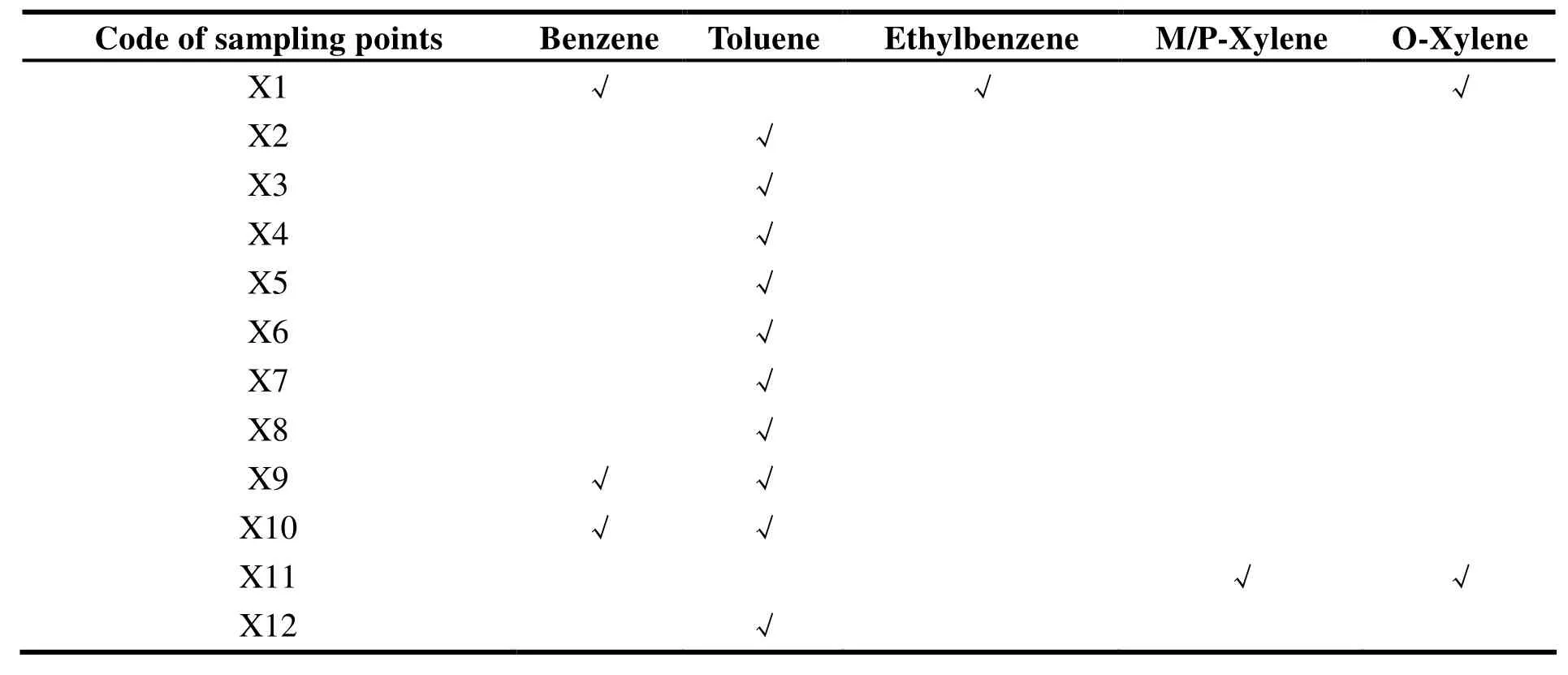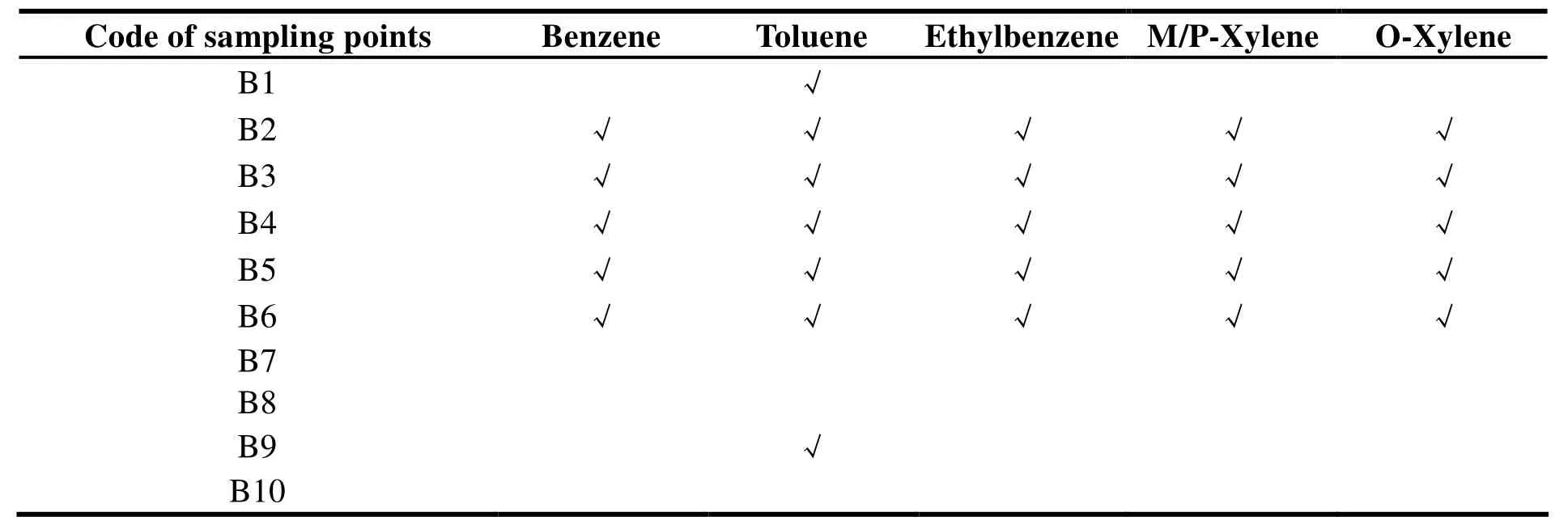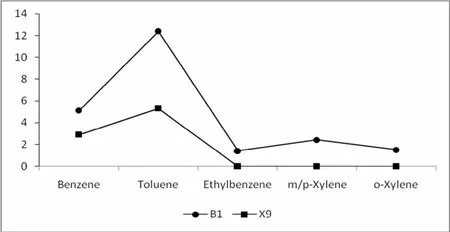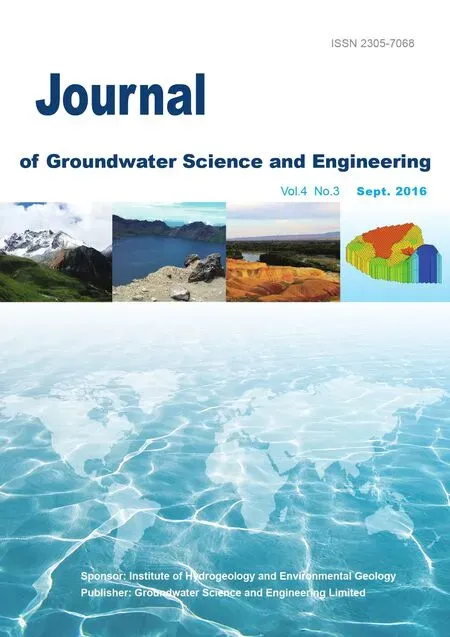Distribution characteristics and source of BTEX in groundwater in Guangzhou, Guangdong Province, P. R. China
2016-12-11LIUChunyanSUNJichaoJINGJihongZHANGYingGUOWeixuan
LIU Chun-yan, SUN Ji-chao*, JING Ji-hong, ZHANG Ying, GUO Wei-xuan
1 Institute of Hydrogeology and Environmental Geology, Chinese Academy of Geological Sciences, Shijiazhuang 050061, China.
2 Hebei Branch of Construction and Administration of South-to-North Water Diversion Middle Route, Hebei Province 05000, China.
Abstract: In order to find out the distribution characteristics of BTEX in groundwater, which include Benzene, Toluene, Ethylbenzene, p-Xylene, m-Xylene, and o-Xylene, 82 groups of groundwater samples and 10 surface water samples collected from Guangzhou in Guangdong during 2005 to 2008 were tested by gas chromatography and mass spectrum(GC/MS). The result showed that the BTEX concentration in groundwater does not exceed the standard. The detection rate of BTEX is 14.63% in groundwater, and the total BTEX concentration is lower than 9.5 µg/L. Of 6 kinds of BTEX, toluene had the highest detection rate (12.20%) and detection value (9.5 µg/L), which was followed by Benzene, with the detection rate of 3.65%,and detection value of 4.9 µg/L respectively; most of samples with BTEX are distributed in Huangpu district, Baiyun district, Huadu district and other industrialized areas; this spatial distribution and urban distribution have obvious consistency. With economic development,plant expansion and population growth led to a large amount of waste water discharge, and infrastructure construction is lagging behind, indicating that rapid urbanization is a major driving force of BTEX in groundwater, and through the analysis of a typical area, it is found that benzene system surface water infiltration was an important source of BTEX in groundwater of Guangzhou.
Keywords: Guangzhou; Groundwater; BTEX; Distribution characteristics; Source to investigate
Introduction
BTEX, including benzene, toluene, ethylbenzene and xylene, are usually extracted from coal tar and petroleum. As the important materials of organic compounds, BTEX are widely used in industrial production, including pharmaceutical process, manufacturing of paint and printing ink,leather tanning, rubber processing, and manufacturing of adhesives, synthetic resins,building and decorative materials. As one of highly toxic carcinogens (LAN Gou-dong and LV Ai-hua,2009; DU Juan et al. 2016; CHA Jian-xi et al.2010), BTEX are responsible for three health hazards. Specifically, benzene causes leukemia,and congenital defects of fetuses; toluene and ethylbenzene do harm to urinary system and bone growth and even incurs mutation and deformity;xylene can affect the muscular and bone growth and also result in deformity because its toxicity is the direct contributor to the decrease of hematoblast and leucocyte (WANG Shuang and DENG Tian-long, 2008; ZHU Fei-fei et al. 2013;US EPA, 2002; ZHANG Yi-jun, 2004). BETX,when used and consumed, can gain an access to groundwater environment through various approaches so that the groundwater system is contaminated. As we all know, groundwater is one of the leading sources for the drinking water for human beings. Once these organic pollutants become the part of groundwater, human health will confront a serious threat. Therefore, in recent years,the BTEX contamination of water environment has drawn much attention from the scholars in China and abroad (ZHOU Wen-min et al. 1990; PAN Jing et al. 2010; DING Zhen-yu et al. 2015; YANG Qing et al. 2014; KANG Xiao-jun et al. 2013; LI Wei et al. 2008; WANG Xin-ming et al. 2002; LI Bing-hua et al. 2006; MA Mottaleb et al. 2003;FENG Ya-nan et al. 2008; ZHANG Ge et al. 2006;JI Jie et al. 2006; LIU Zheng-tao et al. 2006).
Guangzhou is one important industrial base in China and the comprehensive industrial manufacturing center in South China. The rapid economic development has generated some serious environmental problems. According to Water Resources Bulletin 2007 (Water Conservancy Bureau of Guangzhou City, 2007), the water quality in some river reaches of Guangzhou has gone beyond the Environmental Quality Standard for Surface Water(GB3838-2002). These pollution problems concerning water environment have contributed to the“water quality-related water shortage” in Guangzhou. This paper studies the water environment in Guangzhou, a highly industrialized city,collects water samples and analyzes BTEX concentration to gain an insight into the distribution characteristics and source of BTEX in Guangzhou’s water environment. The research findings will be very meaningful for water quality safety and risk assessment (WANG Zhao et al. 2009; WEN Dong-guang et al. 2008; SONG Xiao-yan et al.2006; WANG Zhao et al. 2009; HAN Bing et al.2006), and will provide the scientific basis for future efforts to examine the migration and transformation regularities of BTEX in environment.
1 Overview of study area
Located in the middle-southern part of Guangdong Province and on the northern edge of Pearl River Delta, Guangzhou is the place where three rivers, including West River, North River and East River meet. Guangzhou is the third largest city,which is next only to Shanghai and Beijing, in Mainland China in terms of economic scale, and these three metropolises are collectively named as“Beijing-Shanghai-Guangzhou”. After its vigorous development for years, Guangzhou has developed an export-oriented modern industry system with sophisticated light industry and solid heavy industry, and with strong performance in comprehensive support, scientific research and product development. As the advanced technologies are introduced from abroad, many emerging sectors and high-tech industries including electronics and communication, household electrical appliances,fine chemicals, petrochemical industry have achieved rapid development. There is a dense network of rivers in Guangzhou, Pearl River, East River and Liuxi River meet here and run into the sea through Shiziyang. The alluvial plain and delta plain are characterized by low and flat terrain,highly developed system of surface water, and dense network of rivers, which involves 34 rivers of different sizes. The area of waters totals 160.1 km2, 10.8% of the total area in Guangzhou.The urban development is closely related to the evaluation of urban water system. As the social and economic development and urbanization process accelerate, the discharge of wastewater never ceases to increase, and some river reaches in Guangzhou have been contaminated to different degrees (CHEN Xi, 2007).
The study area is the transitional zone between delta plain and hilly area. The northeastern part is high but the southwestern part is low. As the hilly area which is composed of granites and metamorphic rocks, the northeastern part has an elevation of less than 300 m, the elevation difference of about 250 m and the inclination of 15-35°. The tree-like water system shows the strong slicing results. The western part is the alluvial plain generated by the river deposits. The southern part is the Pearl River Delta Plain which slightly inclines southward. With the ground elevation of 5-7 m, there are some sparsely distributed monadnock and platform. With this vast monadnock area, the luxuriant vegetations,developed rock fractures and exposed bedrocks contribute to the atmospheric precipitation infiltration. Within the monadnock and plain, the red rock strata and sandstones have the considerable contents of mud and mostly the closed fissures.The thick clays on the ground surface cause the poor permeability to prevent the precipitation infiltration. The sand and sandstone strata as the result of alluvial-pluvial sedimentation within Quaternary System can get recharged by river water, and even laterally recharged by fissure water in the bedrock mountainous areas. Besides,the water from those small- and medium-sized reservoirs can recharge groundwater. So the atmospheric precipitation and surface water are two leading sources for groundwater (PENG Wei-ping and RONG Sui-hong, 2006).
2 Materials and methodology
2.1 Sampling
This study collected 82 sets of groundwater samples and 10 sets of surface water samples from 2005 to 2008 (Fig. 1). (Because there are a considerable number of groundwater samples, the figure assigns the numbers merely to sample points,but to all the surface water samples).
The distribution of groundwater sample is based on two to three samples every 200 km2, but gets more dense for the key area. Surface water samples and groundwater sample correspond to each other (the groundwater samples, which are close to surface water samples, are mostly within 100 m away from the latter). All the sampling bottles are brown bottles with the volume of 1 L(inside the bottle cap is PTFE film). The sampling wells with the depth of 32-20 m are mostly the wells for residential purpose. All the water is pumped before sampling starts. After water level recovers, the stainless depth-setting samplers are used to sample water at the depth of 50 cm (the water surface which is about 5 m away from the river bank), and then water samples are slowly poured into sampling bottles (to avoid the exposure to air). After sampling process ends, sampling bottles are placed upside down to check if there are any bubbles inside (if any, water must be resampled), and then are labeled and immediately arranged inside the refrigerator, whose temperature shall be within 0-4 ℃ (ice cube is used).
2.2 Sampling analysis
All the samples are sent to the lab within five days after the collection is completed. The pre-treatment method is the separatory funnel extraction method and the gas chromatography and mass spectrum (GC/MS) is involved in testing process. The standard is based on the method EP-075C as issued by the US. Environmental Protection Agency.
2.3 Quality control of samples
The quality control of samples is achieved through the lab blank samples (pure water samples provided by labs), repeated samples, field blank samples (one set of field blank samples for each batch of samples) and single controlled samples.The testing results show that all the lab blank samples and field blank samples have all their data below the detection limits, and repeated samples and single controlled samples have the same test results, but the latter’s recovery rate falls within the acceptable range (Table 1).
3 Results and discussions
3.1 Distribution characteristics of BTEX in water environment
See Table 2 for the BTEX concentration in water environment of Guangzhou. As indicated in Table 2, BETX is found to exist in 12 sets of water samples, implying a detection rate of 14.63%. Six kinds of BTEX have the total mass concentration of not detected 9.5 µg/L. Toluene has the highest detection rate (12.20%) and detection value(3.7 µg/L), which is followed by Benzene, with the detection rate of 3.65%, and detection value of 4.9 µg/L respectively. Ethylbenzene, m/p-Xylene and o-Xylene are detected only in several sets of water samples, and their maximum detection values are no more than five times of detection limit. Six kinds of BTEX have an average value in groundwater as follows: Benzene>toluene>ethylbenzene>m/p-Xylene>o-Xylene. Six kinds of BTEX do not exceed the stipulated level if we refer to GB5749-2006.
To conclude, BTEX concentration in groundwater of Guangzhou remains at a low level.Specifically, toluene has the largest concentration in groundwater, followed by ethylbenzene. Other four types of BTEX are rarely detected in groundwater. BTEX is mainly distributed in Huangpu District, Baiyun District and Huadu District of Guangdong. The detection result shows that the single kind of BTEX is the main contributor, and two or more kinds of BTEX are detected only in several samples (Table 3).

Fig. 1 Distribution of sample points of Guangzhou

Table 1 The recover result of single controlled sample

Table 2 The concentration of BTEX in groundwater of Guangzhou

Table 3 BTEX components in groundwater samples detected of Guangzhou
3.2 Sources of BTEX in groundwater
3.2.1 Acceleration of urbanization process
In the context of rapid economic growth,urbanization process accelerates, industrial scale continues to expand and rural pollution enters cities in large quantities. From 1984 to 2004,Guangzhou’s GDP increased from 7.21533 billion yuan to 411.581 billion yuan, implying a annual growth of 37.05% due to the positive roles of local backbone industries. The per-capita GDP rose from 1 402 yuan to 56 271 yuan, implying an annual increase of 18.27%. Guangzhou’s wastewater discharge grew from 652.19 million tons to 11.3568 billion tons, representing an annual rise of 2.55%. Specifically, the urban domestic wastewater increased from 244.29 million tons to 919.3 million tons, reporting an annual growth of 6.21%(LI Chun-sheng, 2006). Now Guangzhou has a total of 16.67 million residents, including more than 8.37 million residents without household registration. What’s more, the rising of high-tech industry contributes to a rapid increase in the market demand for BTEX materials. The decorative materials, petrochemical, and coal chemical industry are the main BTEX-related industries. These industries discharge BTEX into environment in the form of “three wastes”. In the urban construction process, many cities lack rational and systematic planning. As a result, the infrastructure construction lags behind in that water supply and sewage system, transportation,underground pipeline network and garbage treatment facilities are in short supply. What’s worse, the rural residents have the limited awareness of environmental protection so that the domestic wastes and many solid wastes, which are hard to get recycled, are randomly arranged, and some household and industrial wastewater is directly discharged. The investigation results show that human activities are significantly related to BTEX in groundwater. Specifically, (1) most sampling points are located inside the urban development land and vegetable farms where human activities prove quite frequent (Fig. 2); (2)BTEX is mainly detected in the groundwater of Huangpu District, Baiyun District and Huadu District where the local industries are highly developed. The investigation of the pollution sites reveals that the dumping grounds around the cities have the directly dumped and untreated wastes,and the rubbish infiltration fluids may directly gather and then infiltrate downward. These cities are mostly distributed on the plain which are composed of the sand and sandstone strata as the result of alluvial-pluvial sedimentation within Quaternary System. The groundwater in alluvialpluvial sand strata is rather shallow, and there is no well-functioning aquiclude on the sand strata. So groundwater and surface water are closely connected, and groundwater is vulnerable to the surface water quality (PENG Wei-ping and RONG Sui-hong, 2006).
3.2.2 Surface water contaminated by BTEX
Guangzhou mainly has the industries like petrochemical, electronics and communication,automobile manufacturing, pharmaceutical, manufacturing of paint and printing ink, leather tanning,rubber processing, and manufacturing of adhesives,synthetic resins and building and decorative materials, and precision optical instruments. To be specific, automobile manufacturing, electronics and communication and petrochemical industry, as three leading sectors of Guangzhou, contribute to about 1/3 of the local gross industrial output value.As a matter of fact, BTEX is an integral participant in the production process of these industries. The sampling points of BTEX are mainly distributed in the enterprises from petrochemical and automobile manufacturing industry, as well as in the dumping grounds. Some enterprises discharge the untreated wastewater directly into the nearby rivers. In addition, wastes can seriously contaminate surface water after the precipitation causes the runoff and wastewater flows into rivers. The lithology of vadose zone in the study area can be defined as sand and sandstones, which can facilitate the infiltration. As a result, contaminants infiltrate along with surface water and then pollute groundwater. BTEX in groundwater and surface water show the striking similarity in terms of distribution characteristics (Fig. 1). This implies that they share the same source. According to the detection result of BTEX in surface water of Guangzhou (Table 4 and Table 5), toluene has the highest detection rate, and other kinds of BTEX also have the high detection rate. One set of benzene has exceeded the criteria.

Fig. 2 Distribution of land-use type of Guangzhou

Table 4 The concentration of BTEX in surface water of Guangzhou

Table 5 BTEX components in surface water samples detected of Guangzhou
To further verify this relationship, this study chooses one nearby well and surface water of a given dumping ground in a typical zone, and collects four sets of surface water samples and groundwater samples during different time segments (one set of groundwater samples and surface water samples during high water period and low water period separately, with the code of X9 and B1, and X10 and B2). The lithology of vadose zone in the study area can be defined as sand and sandstones, so groundwater and surface water have the hydraulic connection to some degree. See Fig. 3 and Fig. 4 for the concentration of benzene, toluene, ethylbenzene, m/p-Xylene and o-Xylene in groundwater and surface water during different time segments. Fig. 3 and Fig. 4 also indicate the concentration of BTEX in the surface water near dumping grounds and in the groundwater of wells near dumping ground. It’s clear that the concentration of BTEX is much higher in groundwater during low water period than during high water period, but lower in groundwater than in surface water. The concentration of BTEX in groundwater decreases once the concentration of BTEX in surface water has declined. This means that BTEX in groundwater and surface water may have the same source. The only difference is that all kinds of BTEX in surface water have a far higher detection rate and concentration than their counterparts in groundwater, and the maximum value of benzene in surface water is above the stipulated level during low water period (based on Standards for Drinking Water Quality GB5749-2006), which implies the contamination of surface water by BTEX. The groundwater sample X8 and surface water sample B4 near the petrochemical enterprise also have this kind of correspondence.
So we can infer that BTEX in the shallow groundwater can have its contamination process described as follows: the wastewater discharged by enterprises and households pollute the nearby surface water, and then the nearby shallow groundwater through infiltration. In this case, if surface water has the serious BTEX contamination,the shallow groundwater concerned may be contaminated to some degree.

Fig. 3 Concentration of BTEX in surface water and groundwater corresponding point in flood period

Fig. 4 Concentration of BTEX in surface water and groundwater corresponding point in low water period
4 Conclusions
(1) BETX in groundwater samples of Guangzhou has a detection rate of 14.63%. Six kinds of BTEX have the total mass concentration of 9.5 µg/L. Toluene has the highest detection rate(12.20%) and maximum detection value (9.5 µg/L),which was followed by Benzene, with the detection rate of 3.65%, and detection value of 4.9µg/L respectively. Ethylbenzene and o-Xylene are detected only in several sets of water samples. Six kinds of BTEX in groundwater of Guangzhou do not exceed the stipulated level.
(2) In the groundwater of Guangzhou, toluene is most widely distributed, then followed by benzene. BTEX is mainly detected in the groundwater of Huangpu District, Baiyun District and Huadu District. In the groundwater samples, single BTEX is mainly detected, and only one set of water sample detects three kinds of BTEX.
(3) The distribution characteristics of BTEX detection points in groundwater and surface water show the striking similarity, and the concentration of BTEX in groundwater water within the typical zone and in surface water at the corresponding point show some noticeable laws during low water period and high water period. The contamination of groundwater by BTEX is much lower when compared to surface water.
(4) The accelerated urbanization process serves as the main contributor to BETX in groundwater,and the infiltration of BTEX-bearing surface water is the essential source of BTEX in groundwater of Guangzhou.
Acknowledgements
This research work was supported by Special Scientific Research Projects on Environmental Protection (201409029); Major Investigation Project of National Land and Resources(1212011121167).
杂志排行
地下水科学与工程(英文版)的其它文章
- Dynamic influence of Holocene characteristics on vadose water in typical region of central North China Plain
- Exploration on compound water circulation system to solve water resources problems of North China Plain
- Evaluation of coordinated development of regional resources and economy around Shandong Peninsula urban agglomerations
- Evaluation of water resources carrying capacity of Gonghe basin based on fuzzy comprehensive evaluation method
- Comprehensive suitability evaluation of urban geological environment in Zhengzhou-Kaifeng area
- Optimization of geothermal water exploitation in Xinji, Hebei Province, P. R. China
